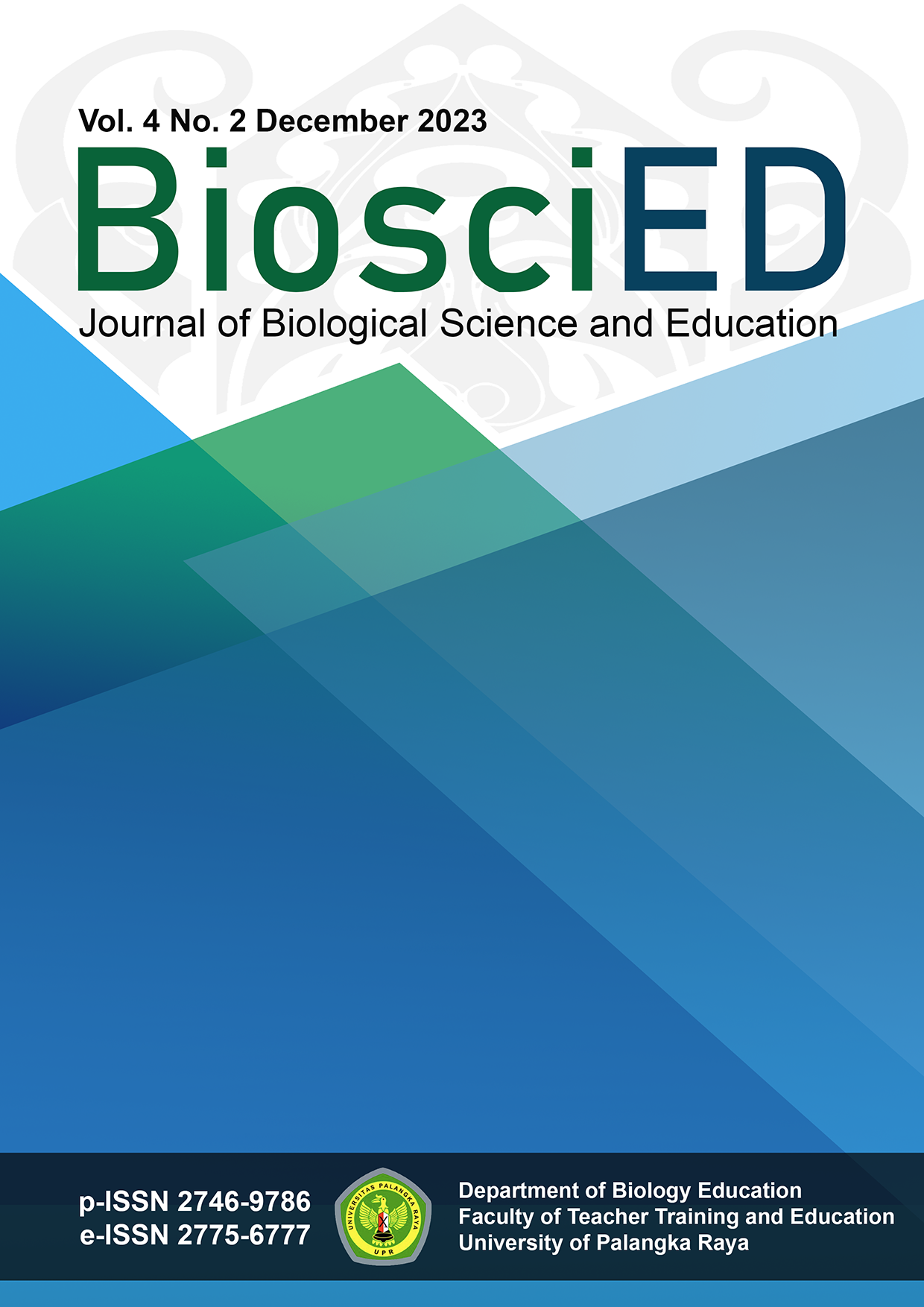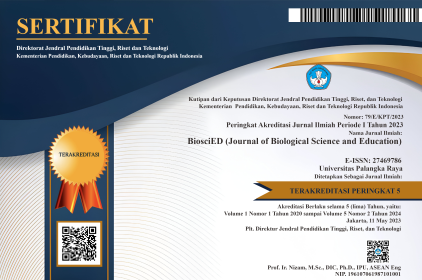Pengaruh Ekstrak Angkak terhadap Fenotip dan Stomata Pakcoy (Brassica rapa L.) yang Dibudidaya dalam Sistem Hidroponik NFT
Effect Of Angkak Extract on Both Phenotype and Stomata of Brassica rapa Cultivated in Hydroponic NFT System
DOI:
https://doi.org/10.37304/bed.v4i2.13721Keywords:
Angkak, Pigmen Monascus, Poliploidi, Brassica rapaAbstract
Penelitian ini bertujuan untuk mengetahui pengaruh ekstrak angkak terhadap fenotip dan stomata dalam menghasilkan tanaman berpotensi poliploidi. Penelitian eksperimen dilakukan dengan menggunakan konsentrasi ekstrak, yaitu 0 (kontrol), 250 mgL-1,500 mgL-1, 750 mgL-1 dan 1000 mgL-1. Data parameter fenotif dianalisa secara kuantitatif menggunakan ANOVA dilanjutkan dengan uji lanjut Duncan, sedangkan data kualitatif dideskripsikan. Ekstrak angkak tidak berpengaruh signifikan terhadap parameter fenotip seperti tinggi tanaman, jumlah daun, berat basah dan tidak ada berat kering. Namun, berpengaruh signifikan pada parameter luas daun. Pengamatan kualitatif stomata menunjukkan bahwa ekstrak angkak dibandingkan dengan kontrol berdampak terhadap bentuk dan ukuran stomata. Potensi poliploidi ditunjukkan pada pengamatan stomata di konsentrasi 750 mgL-1 dan 1000 mgL-1.
Downloads
References
Adisoemarto, S. 1988. Genetika. Jilid 1. Penerbit Erlangga, Jakarta: 186 hal.
Bae, S. J., Islam, M. M., Kim, H. Y., & Lim, K. B. (2020). Induction of tetraploidy in watermelon with oryzalin treatments. Horticultural Science and Technology, 38(3), 385–393. https://doi.org/10.7235/HORT.20200037
Bharati, R., Gupta, A., Novy, P., Severová, L., Šrédl, K., Žiarovská, J., & Fernández-Cusimamani, E. (2023). Synthetic polyploid induction influences morphological, physiological, and photosynthetic characteristics in Melissa officinalis L. Frontiers in Plant Science, 14(December), 1–15. https://doi.org/10.3389/fpls.2023.1332428
Cho, W. Y., Deepo, D. M., Islam, M. M., Nam, S. C., Kim, H. Y., Han, J. S., Kim, C. K., Chung, M. Y., & Lim, K. B. (2021). Induction of polyploidy in Cucumis melo ‘chammel’ and evaluation of morphological and cytogenetic changes. Horticultural Science and Technology, 39(5), 625–636. https://doi.org/10.7235/HORT.20210056
Dabkevičienė, G., Kemešytė, V., Statkevičiūtė, G., Lemežienė, N., & Brazauskas, G. (2017). Autopolyploids in fodder grass breeding: Induction and field performance. Spanish Journal of Agricultural Research, 15(4). https://doi.org/10.5424/sjar/2017154-11357
Dhooghe, E., van Laere, K., Eeckhaut, T., Leus, L., & van Huylenbroeck, J. (2011). Mitotic chromosome doubling of plant tissues in vitro. Plant Cell, Tissue and Organ Culture, 104(3), 359–373. https://doi.org/10.1007/s11240-010-9786-5
Farawahida, A. H., Palmer, J., & Flint, S. (2022). Monascus spp. and citrinin: Identification, selection of Monascus spp. isolates, occurrence, detection and reduction of citrinin during the fermentation of red fermented rice. International Journal of Food Microbiology, 379(March), 109829. https://doi.org/10.1016/j.ijfoodmicro.2022.109829
Haring, F., Farid, M., Sudirman, S., & Anshori, M. F. (2023). The Morpho-Somatic and Chromosomal Changes in Colchicine Polyploidy Induction Colocasia esculenta var. Antiquorium. Plant Breeding and Biotechnology, 11(2), 105–116. https://doi.org/10.9787/PBB.2023.11.2.105
Hartati, S., Samanhudi, Cahyono, O., Wibowo, A., & Afanin, H. (2023). Induction of Polyploidy Using Colchicine in Flower Buds from Phalaenopsis Hybrids (Vol. 2). Atlantis Press International BV. https://doi.org/10.2991/978-94-6463-128-9_41
Hasana, N. (2020). The Effect Of Colchicine on Phenotypes And Stomata Pakcoy (Brassica Rapa L) Hydroponically With The NFT (Nutrient Film Technique) System. Jurnal Biota, 6(1), 37–41. https://doi.org/10.19109/biota.v6i1.5375
Henry, I. M., Dilkes, B. P., Miller, E. S., Burkart-Waco, D., & Comai, L. (2010). Phenotypic consequences of aneuploidy in Arabidopsis thaliana. Genetics, 186(4), 1231–1245. https://doi.org/10.1534/genetics.110.121079
Hsu, Y. W., Hsu, L. C., Chang, C. L., Liang, Y. H., Kuo, Y. H., & Pan, T. M. (2010). New anti-inflammatory and anti-proliferative constituents from fermented red mold rice Monascus purpureus NTU 568. Molecules, 15(11), 7815–7824. https://doi.org/10.3390/molecules15117815
KARA, Z., & YAZAR, K. (2022). Induction of polyploidy in grapevine (Vitis vinifera L.) seedlings by in vivo colchicineapplications. Turkish Journal of Agriculture and Forestry, 46(2), 152–159. https://doi.org/10.55730/1300-011x.2967
Knecht, A., & Humpf, H. U. (2006). Cytotoxic and antimitotic effects of N-containing Monascus metabolites studied using immortalized human kidney epithelial cells. Molecular Nutrition and Food Research, 50(4–5), 406–412. https://doi.org/10.1002/mnfr.200500238
Kusdiyantini, E. (2023). Produksi dan Ekstraksi Pigmen Anka Monascus purpureus pada Beras IR42. Bioma : Berkala Ilmiah Biologi, 24(2), 162–165. https://doi.org/10.14710/bioma.24.2.162-165
Luo, Z., Iaffaldano, B. J., & Cornish, K. (2018). Colchicine-induced polyploidy has the potential to improve rubber yield in Taraxacum kok-saghyz. Industrial Crops and Products, 112(August 2017), 75–81. https://doi.org/10.1016/j.indcrop.2017.11.010
Mahardhika, W. A., Aqlinia, M., Putri, D. A., Effendi, F. S., Maherani, V. F. A., & Listiyowati, S. (2022). Monascus sp. Pigment Potency as Simple Preservative in Food Ingredients. Jurnal Biologi Tropis, 22(3), 781–786. https://doi.org/10.29303/jbt.v22i3.3761
Mahardika, G. B., Nahara, A. R., & Gunawan, S. (2022). Titik Kritis Halal Olahan Natural Products sebagai Bahan Aditif Pangan. Halal Research Journal, 2(2), 112–119. https://doi.org/10.12962/j22759970.v2i2.424
Maity, P., Kasisomayajula, S. V., Parameswaran, V., Basu, S., & Gupta, N. (2008). Improvement in surface degradation properties of polymer composites due to pre-processed nanometric alumina fillers. IEEE Transactions on Dielectrics and Electrical Insulation, 15(1), 63–72. https://doi.org/10.1109/T-DEI.2008.4446737
Niazian, M., & Nalousi, A. M. (2020). Artificial polyploidy induction for improvement of ornamental and medicinal plants. Plant Cell, Tissue and Organ Culture, 142(3), 447–469. https://doi.org/10.1007/s11240-020-01888-1
Pamungkas, E. M. P., Dewi, L., & Tapilouw, M. C. (2022). Penambahan angkak (Monascus purpureus) pada tempe dalam peningkatan antioksidan. Teknologi Pangan : Media Informasi Dan Komunikasi Ilmiah Teknologi Pertanian, 13(2), 144–155. https://doi.org/10.35891/tp.v13i2.2923
Perwati, L. K. (2012). Analisis Derajat Ploidi dan Pengaruhnya Terhadap Variasi Ukuran Stomata dan Spora pada Adiantum raddianum. Bioma : Berkala Ilmiah Biologi, 11(2), 39. https://doi.org/10.14710/bioma.11.2.39-44
Pravitasari, A. D., & Milanda, T. (2020). Fermentasi dan Karakterisasi Berbagai Zat Warna Monascus yang diisolasi dari Angkak. Farmaka, 18(1), 78–83.
Puspita, D., Lestario, L. N., & Al-janati, F. H. (2023). Analisa Pigmen Monascus sp yang Ditumbuhkan pada Berbagai Varietas Beras. Journal Science of Biodiversity, 4(1), 6–11. https://doi.org/10.32938/jsb/vol4i1pp6-11
Sesanti, R. N., & Sismanto. (2016). Pertumbuhan Dan Hasil Pakchoi (Brasicca rapa L.) Pada Dua Sistem Hidroponik Dan Empat Jenis Nutrisi. Kelitbangan, 04(01), 1–8.
Si, J., Yuan, T. Q., & Cui, B. K. (2015). Exploring strategies for adsorption of azo dye Congo Red using free and immobilized biomasses of Trametes pubescens. Annals of Microbiology, 65(1), 411–421. https://doi.org/10.1007/s13213-014-0874-3
Srianta, I., Zubaidah, E., Estiasih, T., Yamada, M., & Harijono. (2016). Comparison of Monascus purpureus growth, pigment production and composition on different cereal substrates with solid state fermentation. Biocatalysis and Agricultural Biotechnology, 7, 181–186. https://doi.org/10.1016/j.bcab.2016.05.011
Srivastav, P., Yadav, V. K., Govindasamy, S., & Chandrasekaran, M. (2015). Red pigment production by Monascus purpureus using sweet potato-based medium in submerged fermentation. Nutrafoods, 14(3), 159–167. https://doi.org/10.1007/s13749-015-0032-y
sudirman, Amier, N., & Rahmat, I. S. (2022). The Morphology Character of Japanese Taro ( Colocasia esculenta var . Antiquorum ) In Induction of Polyploidization Mutations In Vitro : A Case Study of Increased Concentration and Duration of Immersion of Colchicine Mutagens. International Journal of Applied Biology, 6(1), 93–103.
Talebi, S. F., Saharkhiz, M. J., Kermani, M. J., Sharafi, Y., & Raouf Fard, F. (2017). Effect of different antimitotic agents on polyploid induction of anise hyssop (Agastache foeniculum L.). Caryologia, 70(2), 184–193. https://doi.org/10.1080/00087114.2017.1318502
Tang, Z. Q., Chen, D. L., Song, Z. J., He, Y. C., & Cai, D. T. (2010). In vitro induction and identification of tetraploid plants of Paulownia tomentosa. Plant Cell, Tissue and Organ Culture, 102(2), 213–220. https://doi.org/10.1007/s11240-010-9724-6
Tangboriboon, N., Chaisakrenon, S., Banchong, A., Kunanuruksapong, R., & Sirivat, A. (2012). Mechanical and electrical properties of alumina/natural rubber composites. Journal of Elastomers and Plastics, 44(1), 21–41. https://doi.org/10.1177/0095244311416579
Umamaheswari, S., Malkar Oli, S., & Naveena, K. (2017). FTIR spectral and microarchitectural analysis of cellulose produced by Lactococcus lactis under agitated condition. Journal of Pure and Applied Microbiology, 11(4), 1965–1971. https://doi.org/10.22207/JPAM.11.4.38
Wang, F., Zhuo, X., Arslan, M., Ercisli, S., Chen, J., Liu, Z., Lan, S., & Peng, D. (2023). In Vitro Induction of Polyploidy by Colchicine in the Protocorm of the Orchid Dendrobium wardianum Warner. HortScience, 58(11), 1368–1375. https://doi.org/10.21273/HORTSCI17355-23
Wiendra, N. M. S., & Pharmawati, M. (2019). Morphological and Anatomical Changes by Cochicine in Seedling of Impatiens balsamina L. Advances in Tropical Biodiversity and Environmental Sciences, 3(2), 33. https://doi.org/10.24843/atbes.2019.v03.i02.p04
Wu, J., Zhou, Q., Sang, Y., Zhao, Y., Kong, B., Li, L., Du, J., Ma, L., Lu, M., & Zhang, P. (2023). In vitro induction of tetraploidy and its effects on phenotypic variations in Populus hopeiensis. BMC Plant Biology, 23(1), 1–13. https://doi.org/10.1186/s12870-023-04578-0
Wu, Y., Sun, Y., Sun, S., Li, G., Wang, J., Wang, B., Lin, X., Huang, M., Gong, Z., Sanguinet, K. A., Zhang, Z., & Liu, B. (2018). Aneuploidization under segmental allotetraploidy in rice and its phenotypic manifestation. Theoretical and Applied Genetics, 131(6), 1273–1285. https://doi.org/10.1007/s00122-018-3077-7
Xie, N., Zhao, Y., Huang, M., Chen, C., Cao, C., Wang, J., Shi, Z., & Gao, J. (2024). Polyploid Induction and Identification of Begonia × benariensis. Horticulturae, 10(1). https://doi.org/10.3390/horticulturae10010047
Yuliana, A. (2018). Isolasi Zat Warna Baru Monascus purpureus Dari Hasil Fermentasi Padat Dengan Beras Sebagai Substrat. Journal of Pharmacopolium, 1(1), 178–185. https://doi.org/10.36465/jop.v1i1.391
Downloads
Published
How to Cite
Issue
Section
License
Copyright (c) 2023 Ike Apriani, Nurdiah Hasanah

This work is licensed under a Creative Commons Attribution 4.0 International License.















